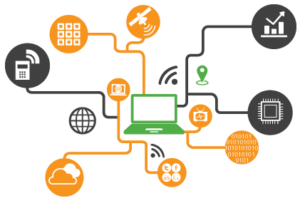
What is Internet of Things (IoT)?
Internet of Things (IoT) is an ecosystem of connected physical objects that are accessible through the internet. The ‘thing’ in IoT could be a person with a heart monitor or an automobile with built-in-sensors, i.e. objects that have been assigned an IP address and can collect and transfer data over a network without manual assistance or intervention. The embedded technology in the objects helps them to interact with internal states or the external environment, which in turn affects the decisions taken.
IOT enables devices/objects to observe, identify and understand a situation or the surroundings without being dependent on humans. By gathering and processing vast amounts of data its possible to quantify and analyse all manner of things that was once done intuitive and inexact.
What is the scope of IoT?
Internet of Things can connect devices embedded in various systems to the internet. When devices/objects can represent themselves digitally, they can be controlled from anywhere. The connectivity then helps us capture more data from more places, ensuring more ways of increasing efficiency and improving safety and IoT security.
IoT is a transformational force that can help companies improve performance through IoT analytics and IoT Security to deliver better results. Businesses in the utilities, oil & gas, insurance, manufacturing, transportation, infrastructure and retail sectors can reap the benefits of IoT by making more informed decisions, aided by the torrent of interactional and transactional data at their disposal.
How can IoT help?
IoT platforms can help organizations reduce cost through improved process efficiency, asset utilization and productivity. With improved tracking of devices/objects using sensors and connectivity, they can benefit from real-time insights and analytics, which would help them make smarter decisions. The growth and convergence of data, processes and things on the internet would make such connections more relevant and important, creating more opportunities for people, businesses and industries.
A few applications of IOT are given below.
- Cainthus, an Irish company is using IOT to boost productivity. It uses camera in barns to track cows in barns and fields relying on machine learning to analyse the images and to alert farmers if the cow is not feeding or moving as it should be.
- An Austrian firm has developed a sensor that could be swallowed, it lodges in the stomach of the cow, monitoring the body temperature, movement and stomach acidity, uploading results when the cow is near a metal detector ensuring that early detection can reduce the use of antibiotics.
- Customers of Ping An, a Chinese insurer, can use the firms face recognition software when registering accounts. One of the datapoints extracted from the face is a person’s body -fat percentage that is fed into the algorithms that calculates their life insurance premium.
- Beam, an American Dental Insurance firm supplies policy holders with internet connected smart toothbrushes. Diligent brushes can save 15% on their premium.
- Siemens uses an app called comfy that allows the workers to adjust temperature and light levels in their offices with their phones. Over time the system will learn the preferences of the individual workers and automatically warm and light their offices.
- Smart homes in which consumers can use voice activated window binds and mattresses that track heart rate and sleep patterns.
- Pampers has come up with Lumi, a sensor clipped to dispensable nappies and sends smartphone alerts to parents about diaper change.